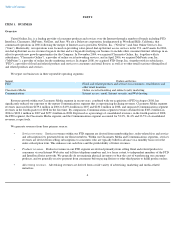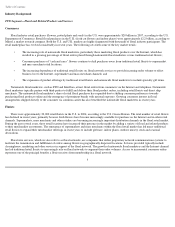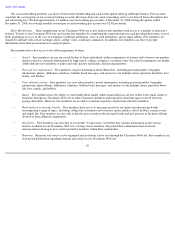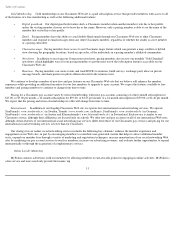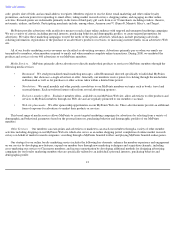Classmates.com 2008 Annual Report Download - page 7
Download and view the complete annual report
Please find page 7 of the 2008 Classmates.com annual report below. You can navigate through the pages in the report by either clicking on the pages listed below, or by using the keyword search tool below to find specific information within the annual report.
Table of Contents
Industry Background
FTD Segment—Floral and Related Products and Services
Consumers
Floral industry retail purchases (flowers, potted plants and seeds) in the U.S. were approximately $20 billion in 2007, according to the U.S.
Department of Commerce. Retail floral purchases in the U.K. (fresh cut flowers and indoor plants) were approximately £
2.2 billion, according to
Mintel, a market research company. Both the U.S. and U.K. markets are highly fragmented with thousands of floral industry participants. The
retail marketplace has evolved considerably in recent years. The following sets forth some of the key market trends:
• The increasing role of nationwide floral marketers, particularly those marketing floral products over the Internet, which has
resulted in a growing percentage of floral orders placed through nationwide floral marketers versus traditional retail florists;
•
Consumer purchases of "cash and carry" flowers continue to shift purchases away from traditional retail florists to supermarket
and mass merchant retail locations;
•
The increasing dependence of traditional retail florists on floral network services to provide incoming order volume to offset
business lost to the Internet, supermarket and mass merchant channels; and
• The expansion of product offerings by traditional retail florists and nationwide floral marketers to include specialty gift items.
Nationwide floral marketers, such as FTD and Interflora, attract floral orders from consumers via the Internet and telephone. Nationwide
floral marketers typically partner with third-parties to fulfill and deliver their floral product orders, including retail florists and direct ship
merchants. The nationwide floral marketer's share of retail floral purchases has expanded due to shifting consumer preferences towards
purchasing floral products online and the emergence of prominent brands with national exposure. Growing consumer interest in floral
arrangements shipped directly to the consumer via common carrier has also benefited the nationwide floral marketers in recent years.
Florists
There were approximately 22,000 retail florists in the U.S. in 2004, according to the U.S. Census Bureau. The total number of retail florists
has declined in recent years, primarily because fresh flowers have become increasingly available for purchase on the Internet and in other retail
channels. Supermarkets, mass merchants and other retailers are becoming increasingly important distribution channels in the floral retail market.
During the past several years, these retail locations have increased their presence in the market by adding a variety of floral and related products
to their merchandise assortments. The emergence of supermarkets and mass merchants within the floral retail market has led many traditional
retail florists to expand their merchandise offerings in recent years to include giftware, indoor plants, outdoor nursery stock and seasonal
decorations.
Floral wire services, which we also refer to as floral networks, are companies that utilize proprietary network communications systems to
facilitate the transmission and fulfillment of orders among florists in geographically dispersed locations. Services provided typically include
clearinghouse, marketing and other services in support of the floral network. The growth of nationwide floral marketers and the Internet channel
has led traditional retail florists to increasingly rely on floral networks to augment their order volumes. Access to incremental consumer orders
represents one of the principal benefits a florist receives from membership in a floral network.
5






